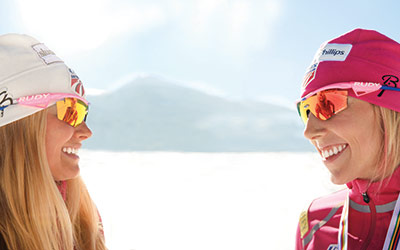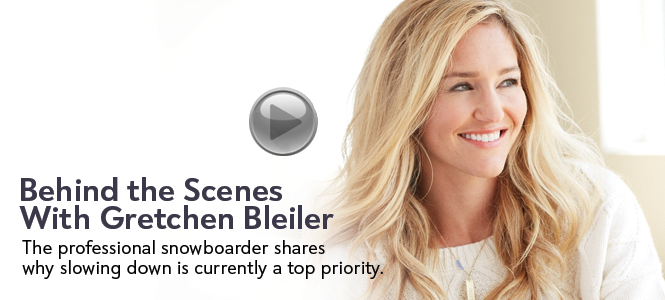Editor’s Note: Julia Mancuso announced Friday, January 29, 2018, that she has retired from alpine skiing.
Julia Mancuso mastered the bunny slope when she was just 4 years old. “There was a great ski program for kids in Squaw Valley, Calif., where I grew up,” she recalls. “On weekends, my parents would drop me off and I’d ski all day.”
She started alpine-ski racing before she reached junior high and debuted on the elite World Cup stage at 15. In 2005 the then 21-year-old phenom scored bronze medals in super-G (super-giant slalom) and giant slalom races.
A year later, at the Olympic Games in Turin, Italy, she won her first Olympic gold medal in the giant slalom, despite nursing a nagging injury.
“It’s inevitable that you’re going to have an injury when you’re skiing, because you’re going so fast and you can’t predict how your skis are going to react underneath you,” she says. “It’s hard to stay on your feet all the time.”
Even though she’s fallen down, Mancuso doesn’t let injuries keep her from hitting the slopes. In fact, comebacks — and high-pressure performances — seem to be her sweet spot.
After having surgery to correct hip dysplasia in 2006, she won her first World Cup race in 2007 and finished the season in third place overall. It was the best finish for an American female skier since 1984.
Though she was hobbled by back injuries in 2008 and 2009, Mancuso nabbed two silver medals at the 2010 Vancouver Games, which revitalized her career. In the subsequent World Cup season, she found herself on the podium after multiple races.
Yet she felt her performance was lagging, so she decided to take a break from racing to prepare for the 2014 Olympics. The strategy worked: She left Sochi with a bronze medal — her fourth overall.
Mancuso underwent a second hip surgery in November 2015 to fix degenerating cartilage. Her recovery has kept her from World Cup competition since then. Despite the extended break, she’s set her sights on the 2018 Winter Games in Pyeongchang, South Korea.
While she admits at times to feeling behind in her training, she’s armed with “a stubborn drive and a positive mindset.” Those two traits have helped propel her to the top of her sport — time and time again.
Q&A
Experience Life | You played several sports as a kid. What made you choose alpine skiing?
Julia Mancuso | I played soccer and did gymnastics, but I loved skiing the most because of the freedom it offered. I didn’t have to play with a team or show up at a certain time. Then there’s the adrenaline aspect of skiing and racing that can’t be beat.
I also love the aspect of being outside. Nature is invigorating, and as a kid I was inspired to just be in the fresh air. It still gives me a ton of energy, and I’m outside as much as possible these days, whether it’s on skis or a paddleboard.
EL | You’ve had multiple surgeries. What do you do to support your recovery?
JM | After my first hip surgery, I recovered well with strength training and physical therapy. But I started to have back pain because of the constant compensation patterns that I formed, so I had to seek out other options.
I tried lots of things and discovered a technique called NeuroKinetic Therapy Pilates, which is basically using Pilates equipment and machines to connect your brain with the correct movement patterns.
It also applies the philosophy of anatomy trains. These are lines of bone and connective tissue running throughout the body that organize the structural forces required for motion and may serve as conduits for modalities like acupuncture.
This allowed me to re-create disc space in my back. I’ve been doing it ever since, along with physical therapy and a lot of body-weight strength training.
EL | What have been the biggest challenges of recovery?
JM | One is that I had to learn to walk again. I spent three months using crutches and then three months using a cane. That was physically and mentally hard. Doctors never tell you that recovering is going to take you longer than you think it will or should.
For me, other people’s perception is probably the hardest thing. We all deal with going through something tough in our own ways, but when I run into people and they ask me what’s wrong because I’m limping, or they look at me with sad eyes, it’s hard. I don’t want people to pity me.
EL | What have you learned during the recovery process?
JM | Taking a break from racing helped me recenter and reset my mind, and rest my body. The only pain I have now is in my hip.
Since I couldn’t be active, I studied a lot about nutrition. I’ve always had a great diet and focused on eating organic, but I was never precise about it because I didn’t have to be. I was working out and skiing so many hours each day that it didn’t really matter if I got off-course a bit or ate a little more sugar.
But during this recovery period, I got into health coaching and began fine-tuning what I ate. I focused on what was healthy for me and what made me feel good and what didn’t. It was a lot easier to tell the difference when I wasn’t burning so many calories a day.
My health-coaching training also helped me see how connected everything is on a basic level — our exercise, our nutrition, our habits, and our mindset. I’m a firm believer in setting intentions, the power of positive thinking, and creating what you want, and I’ve been trying to heal myself in all those ways, too.
EL | What’s helped you be so successful in your sport and your life?
JM | I have always set intentions and believed I could achieve them. I used to get in trouble with my coaches when I filled out goal sheets because I would write that I wanted to be the best and I wanted to get first place. They often told me to set realistic goals, and I never understood why I would put down something less than what I wanted.
But I didn’t really fixate on being the best at my sport compared with other people. I focused on being the best at my sport for myself and really challenging my own skill. Comparing yourself with others is a good way to end up feeling unhappy and unfulfilled.
EL | What will it mean to you when you’re back on Team USA?
JM | Yes, when I make the Olympic team — that’s how you set an intention!
When I was training for the 2014 games, I was skiing well, but I had a setback during the Olympics. Even though I won a bronze medal, I felt like I left a lot on the slopes. That’s when I set the goal that I’m going to the Olympics in South Korea as prepared as I can be and I’m going to win another medal.
But as I’ve been recovering and training, I’ve gained a new perspective on how meaningful it is to even be a part of the sport and to just make the Olympic team. I’ve come full circle. Instead of ending my career at the top, I’m back to the mindset that I had when I first made the team, which gives me better insight on how to inspire the next generation. I know what it’s like to fight hard and to come back, and I know what it’s like to want something so bad and not understand how to get it.
I’m a huge Olympics fan. The Olympic spirit isn’t about who’s winning the medals — it’s about bringing people together and representing the pinnacle of your sport. I want to be a part of that.




This Post Has 0 Comments